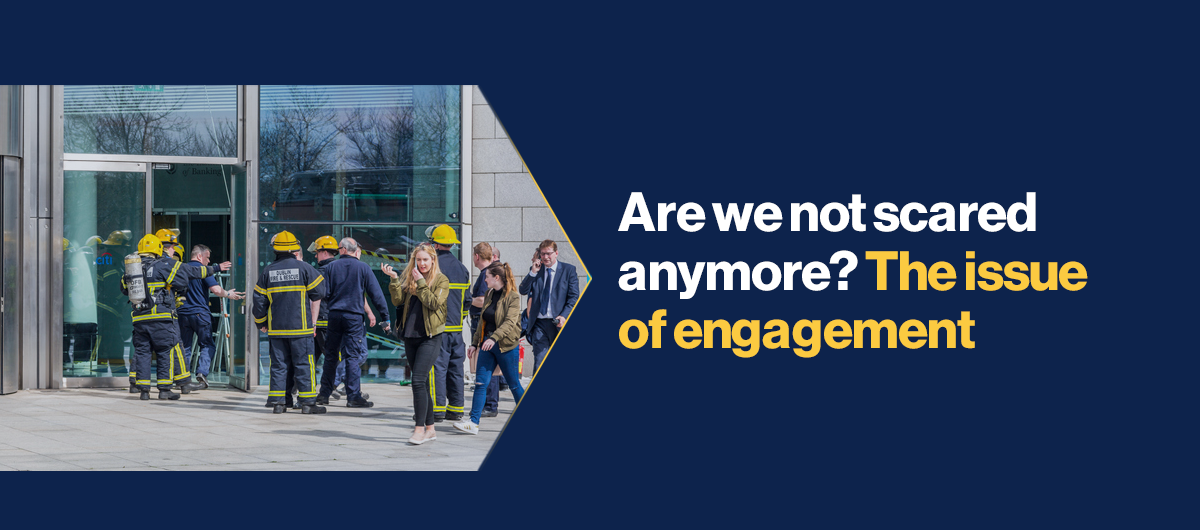Are we not scared anymore? The issue of engagement

Monday evening at the gym. A gathering of sweaty people trying to burn the ‘too-many’ calories gained during the weekend. Nobody is happy to be there; we are all plugged-in with our headphones with loud music thinking, ‘just get it done’ ‘get it over and you are out of here’. As I am doing some sort of press exercise with my dumbbells, I hear in the background an announcement coming from the gym’s speakers. I look around and take out my Air Pods, a couple of people are looking at each other, but there is no major reaction. I think to myself ‘maybe it’s just an ad’; as I put my headphones back in another announcement comes on: ‘This is an emergency, please evacuate the building immediately’.
I am not a business continuity professional but working within the industry has made me more responsive to situations like these. So, I dropped the weights and headed straight out. As I was marching towards the exit, I looked back and saw that I was only one of a few people evacuating the building. Most people were still carrying on with their workouts – many of them did not even flinch. The announcement was played again, and the Personal Trainers started asking the remaining customers to please leave the building immediately as it could have been dangerous for them to stay. In the end, the building was evacuated, but it took time, customers were not cooperative at all, and complained all the way out!
As we walked to the car park, we were asked to gather around. Everyone was quite calm; some people started to question if it was a real emergency, others complained that their workout had been interrupted. As the chattering continued, the gym manager approached us and announced, ‘it was a fire drill, thank you for your collaboration’. The customers’ reaction? Not happy. Not happy at all.
As I witnessed all of this, I started to think, are we not scared of potential threats to our lives anymore? Have we not learned from past experiences? It could have been a fire, an active shooter, a terrorist attack… it could have been a real incident – and we are very aware that these can happen – and what do we do? We complain about the disruption that the drill has caused to our workout.
We live in a very unpredictable world; we have witnessed real incidents and crisis situations, and we are aware that they can happen – in some cases their likelihood is quite high too. But when we are asked to ‘prepare’ for these events so that we can react to them we just refuse to do so.
Coincidentally, a BCAW 2021 theme focuses on Business Continuity awareness within organizations, I wondered if Business Continuity professionals encounter the same problem when running their exercises? Although drills and exercises are two different things, they both have as common denominator: engagement and preparedness.
The BCAW 2021 Case Study Report shows the different ways Business Continuity Professionals can engage with staff and employees. Particularly, how to make them aware of threats, risks, what to do in case of an incident, and how to prevent one. But looking at the ways they have carried out their awareness campaign and exercises, ‘traditional’ methods are not enough.
Is there a ‘one size fits all’ solution that gets people engaged during exercises? The answer is no. Every audience is different, and every organization has its own culture, which requires a different approach. I (virtually) sat down with Crisis Management expert, Jim Preen, from YUDU Sentinel, to ask him for some evergreen best practices that can be applied when planning and executing an exercise. He highlighted that ‘Before starting to plan a simulation you need to ask two questions: why are we doing this exercise and what do we expect to get out of it? Everything about the exercise flows from the answers to these questions.’
But what about the participants? How do we engage with them and grab their attention? Knowing your audience and their skills is a key element to consider when putting together your scenario – Preen commented, ‘if the scope of the exercise is beyond the experience and skills of the participants, you will likely run into trouble’. He continued ‘You could end up highlighting an individual’s inexperience, which may be an exercise outcome, but it could destroy the participants confidence. If this happens people won’t learn from the exercise experience.’
Jim went on, ‘Don’t repeat what you’ve done before. If people feel they are just going over the same old ground, you will lose their attention. The chosen scenario needs to pose new questions and challenges.’ He also advises, ‘Don’t patronize the players. If you do, you’ll lose them, and their engagement will lapse.’
The mistake that is often made is to think of exercises as training sessions – they are not. Training provides individuals with the skills they need to perform certain tasks. Exercising tests whether plans, processes and structures are fit for purpose. Confuse the two and an exercise may come off the rails.
Exercises are not, and never should be, a test of individuals.
A simulation is similar to the start of a film or play. You need to grab the participants’ attention. The exercise must start on time, all the collateral should be in place, the videos must work, and whiteboards should be available. Because of Covid people will likely be joining the exercise online. Exercise planners will need to ensure that those people not in the room feel part of the event. An exciting, seamless start is essential. If these suggestions are followed and the exercise is well planned, then the players will quickly lose any misgivings they might have as they become wrapped up in the scenario.
For all that, I am still thinking about the drill at my gym. Most people did not move from their workout stations until they were forced to do so and then grumbled all the way out of the building. How do we get them and others like them on board? How do we make them see that both drills and exercises are important for their safety? Just announcing an evacuation over the PA system is not enough. To get people’s attention during a drill and to capture people’s imagination during an exercise you are going to need to be creative and creativity means careful thought and hard work.











































